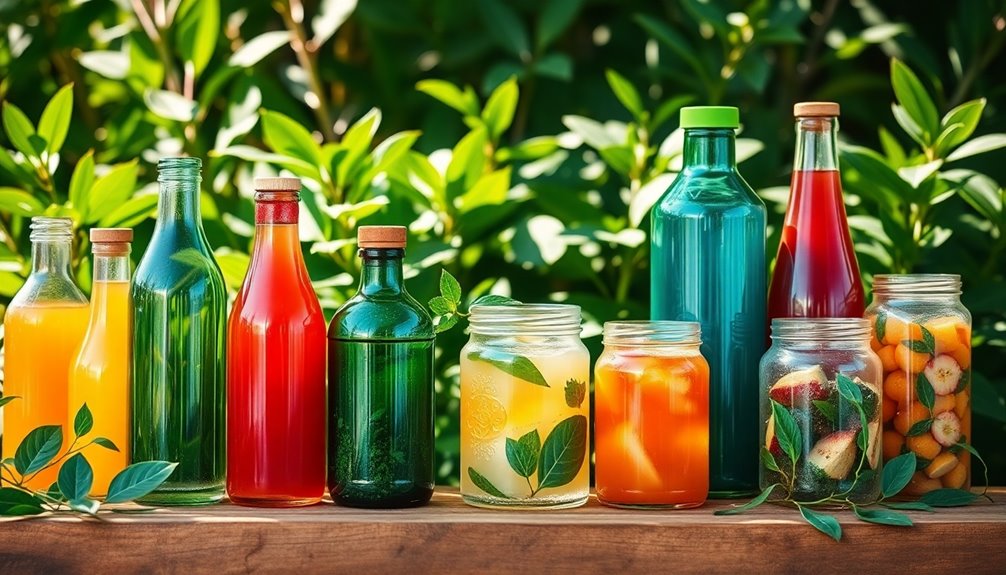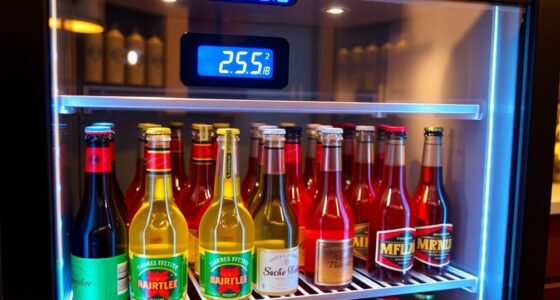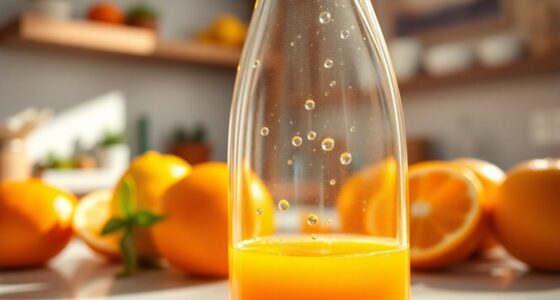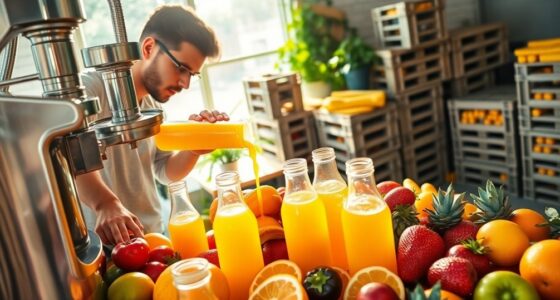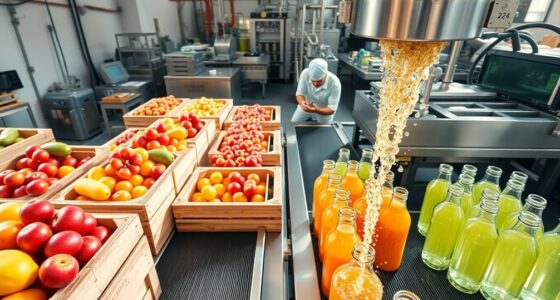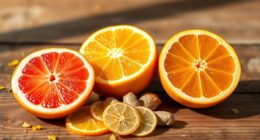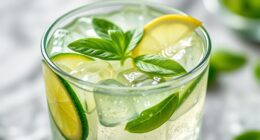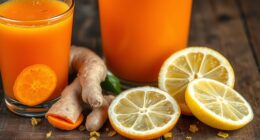For naturally fresh drinks, embracing sustainable packaging is key. You can choose biodegradable materials like compostable paper and bioplastics that reduce waste and offer eco-friendly alternatives. Innovative solutions, such as aseptic beverage cartons and edible coatings, enhance product safety and shelf life. Plus, with increasing consumer demand for greener options, it’s easier than ever to make an environmentally responsible choice. Explore more about the latest trends in sustainable packaging to elevate your beverage experience. This shift not only benefits the environment but also aligns brands with the growing movement towards sustainability. By participating in the green revolution in beverage packaging, companies can attract eco-conscious consumers who prioritize environmental impact in their purchasing decisions. Moreover, adopting these practices can lead to innovative marketing strategies that highlight a brand’s commitment to preserving the planet, ultimately fostering customer loyalty and trust.
Key Takeaways
- Aseptic beverage cartons made from renewable materials provide a sustainable option for storing natural drinks with a low carbon footprint.
- Bioplastics, such as PLA and PHA, serve as eco-friendly packaging alternatives, reducing reliance on fossil fuels for natural drink packaging.
- Compostable packaging, like foldable boxes and bowls, enhances usability while promoting sustainability in the natural drinks market.
- Seaweed-based packaging decomposes quickly, offering an innovative and environmentally friendly solution for natural drink storage.
- Edible coatings from natural ingredients extend shelf life, providing additional nutritional benefits while maintaining sustainability in packaging.
The Importance of Sustainable Packaging for Natural Drinks
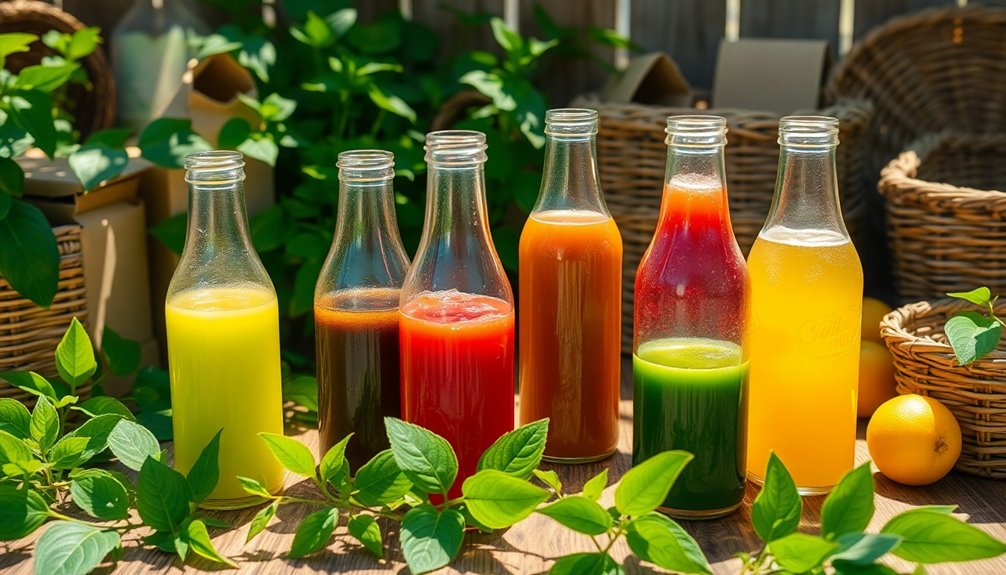
As consumers become more environmentally conscious, the importance of sustainable packaging for natural drinks can't be overstated.
Sustainable packaging solutions play an essential role in reducing packaging waste, especially as it accounts for over 66% of total packaging in developed nations.
The EU's initiative to ban single-use plastics highlights the urgent need for eco-friendly alternatives, driving the beverage industry towards biodegradable and compostable materials.
Aseptic beverage cartons made from up to 95% renewable materials not only provide a low-carbon footprint but also guarantee product safety for up to 12 months. Moreover, incorporating ingredients like chia seeds can further enhance the nutritional profile of natural drinks while promoting digestive health.
Key Biodegradable Materials Used in Packaging
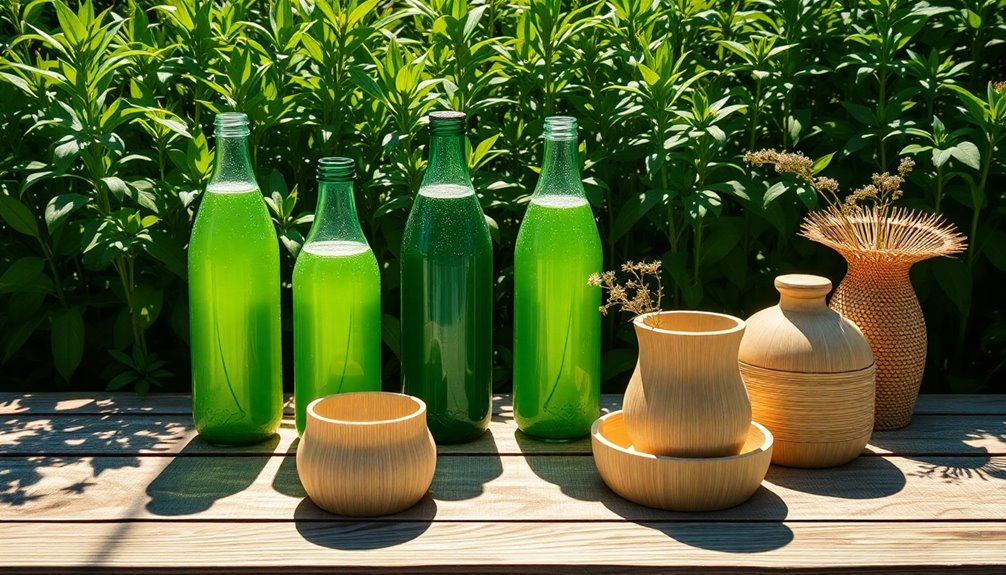
When you're looking for sustainable packaging options, consider compostable paper products and innovative bioplastics.
These materials not only break down naturally but also offer a way to reduce environmental impact.
Compostable Paper Products
Compostable paper products offer a sustainable solution for packaging by decomposing biologically and enriching the soil, making them a smart choice for environmentally conscious businesses.
These materials serve as an eco-friendly alternative to traditional packaging, considerably reducing the environmental impact associated with plastic waste.
Innovative designs, like foldable compostable boxes and sustainable folding cartons, are now being used for food containers and trays, enhancing user convenience.
Companies such as Chipotle and A&W Canada are leading the way by adopting compostable bowls, cups, and sleeves in their packaging strategies.
Bioplastics Innovations
Bioplastics innovations are transforming the packaging landscape for natural drinks, offering eco-friendly materials that meet both functional and environmental needs.
Bioplastics like Polylactic Acid (PLA) and Polyhydroxyalkanoates (PHA) are derived from renewable resources, greatly reducing reliance on fossil fuels.
For instance, Coca-Cola's PlantBottle technology showcases how bioplastics made from sugarcane can lower carbon footprints while maintaining packaging durability.
Designed to be biodegradable, these materials break down into natural substances, minimizing their environmental impact and addressing plastic pollution.
Companies are now providing custom packaging solutions using bioplastics, catering to the beverage industry's demand for sustainable alternatives. Additionally, the adoption of renewable energy sources in the production process of these bioplastics further enhances their sustainability profile.
Innovations in Compostable Paper and Cardboard
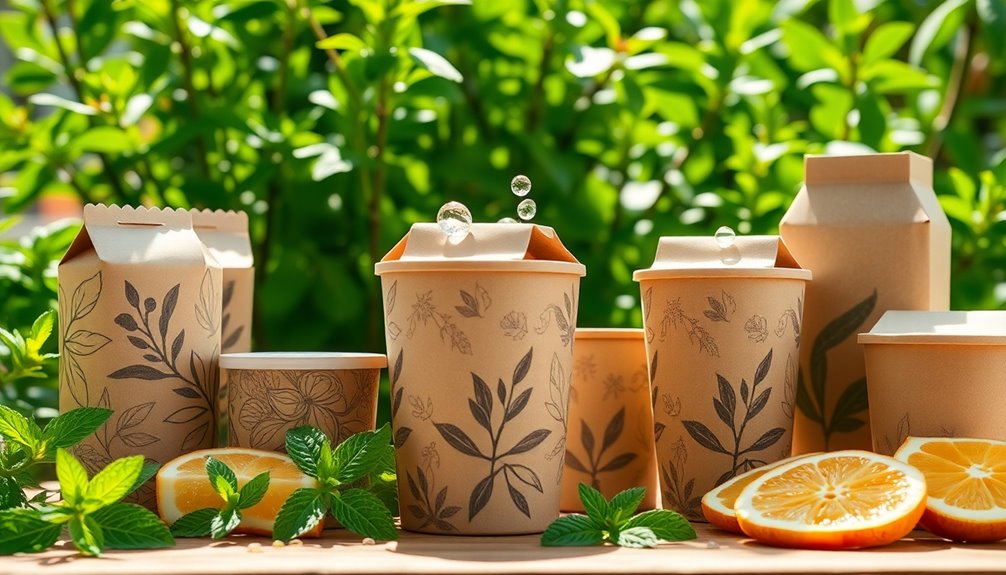
When you consider eco-friendly packaging alternatives, compostable paper and cardboard stand out as smart choices.
Innovative designs, like foldable boxes, not only enhance functionality but also support sustainable practices.
Eco-Friendly Packaging Alternatives
As consumers increasingly prioritize sustainability, eco-friendly packaging alternatives like compostable paper and cardboard are gaining traction in the market.
These eco-friendly materials decompose into nutrient-rich soil, reducing waste and offering a viable replacement for traditional packaging.
Companies such as Chipotle and A&W Canada are leading the charge by adopting compostable bowls, cups, and sleeves, showcasing the trend toward sustainable packaging solutions in the foodservice industry.
Compostable packaging is particularly effective for food containers and cardboard trays for perishables, aligning perfectly with the natural drinks market's needs. Additionally, the adoption of renewable energy technologies in production processes can further enhance the sustainability of packaging solutions.
Innovative Design Solutions
Embracing innovative design solutions in compostable paper and cardboard packaging not only enhances functionality but also addresses the urgent need for sustainability in the natural drinks market.
These innovative designs, like foldable compostable boxes and sustainable folding cartons, streamline usability while considerably reducing your environmental footprint.
Companies such as Chipotle and A&W Canada showcase effective compostable packaging solutions, proving that eco-friendly materials can be practical in food service.
By opting for compostable containers and cardboard trays, you contribute to reducing waste associated with traditional packaging.
As consumer demand for recyclable materials grows, the shift towards compostable options in natural drink packaging drives industry innovation, making a positive impact on the planet and encouraging a greener future. Additionally, this move aligns with the growing focus on ethical implications of AI in developing sustainable technologies and practices across various sectors.
Compostable Materials Benefits
Using compostable materials in packaging not only supports your commitment to sustainability but also offers practical benefits for the environment. These materials, like innovative compostable paper and cardboard, decompose biologically, transforming into nutrient-rich soil rather than contributing to plastic waste.
Companies such as Chipotle and A&W Canada have successfully integrated compostable bowls and cups, showcasing their dedication to eco-friendly food packaging solutions.
With options like foldable compostable boxes and sustainable folding cartons, you can enhance your packaging strategy while promoting a circular economy. By choosing compostable materials for food containers and trays, you help reduce landfill waste and foster a greener future, making a positive impact on our planet. Additionally, adopting sustainable packaging solutions can further drive eco-conscious consumer behavior and support your brand's environmental goals.
The Role of Bioplastics in Eco-Friendly Packaging
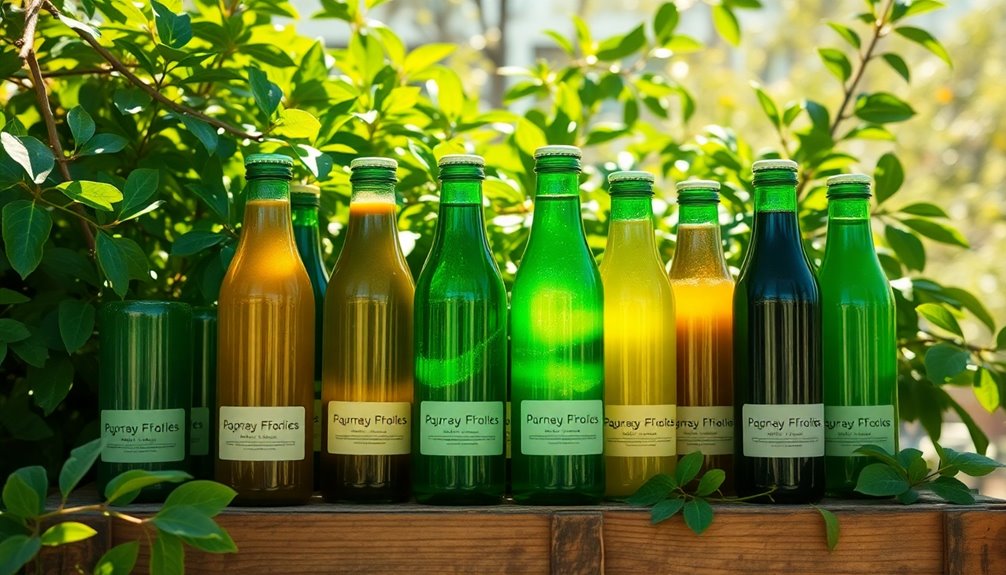
Bioplastics play a crucial role in creating eco-friendly packaging solutions that meet the growing demand for sustainability.
Derived from renewable biological sources like corn starch and sugarcane, bioplastics markedly reduce greenhouse gas emissions compared to conventional plastics.
Common types, such as Polylactic Acid (PLA) and Polyhydroxyalkanoates (PHA), are biodegradable and can decompose under specific conditions, promoting a circular economy.
Innovations like Coca-Cola's PlantBottle technology showcase how bioplastics can be used to create recyclable beverage bottles, further minimizing reliance on fossil fuels.
The increasing consumer awareness and regulatory support for sustainable packaging practices are driving the global bioplastics market, indicating a clear shift toward greener solutions in the packaging industry.
Embracing bioplastics helps you contribute to a more sustainable future. High-quality content is essential in establishing brand credibility and trust in the eco-friendly market.
Exploring Biodegradable Films for Beverage Protection
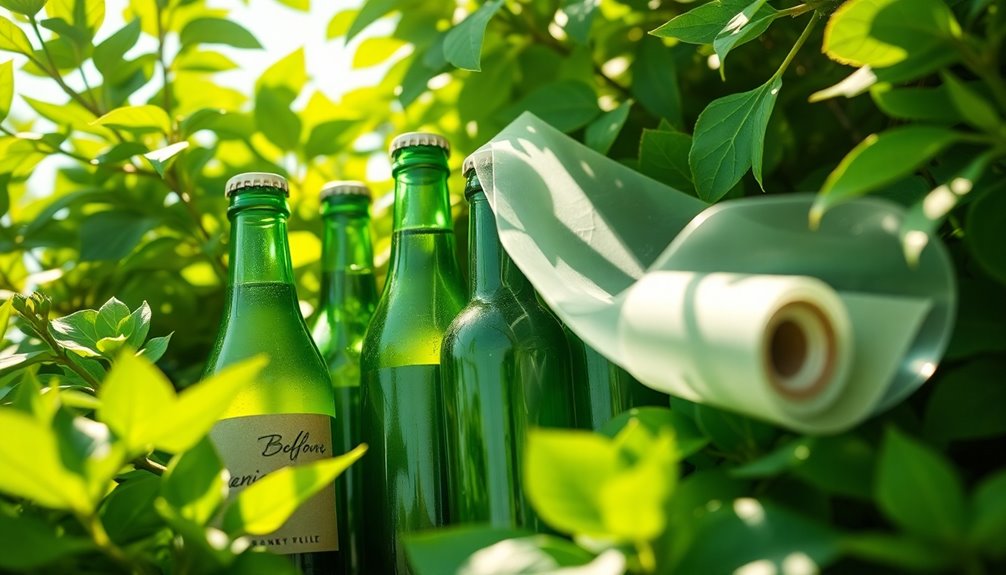
As the demand for sustainable packaging grows, biodegradable films are emerging as a viable solution for protecting beverages while minimizing environmental impact.
These films, like cellophane made from plant cellulose, serve as eco-friendly alternatives that naturally decompose, reducing plastic waste. They provide essential barrier properties to shield beverages from contaminants and moisture, making them a smart choice compared to traditional plastics.
You'll find biodegradable films used in applications like shrink wrap for fresh juices, ensuring freshness without compromising environmental integrity.
Innovations in edible biodegradable films, derived from materials such as seaweed or fruit extracts, not only cut down on packaging waste but also enhance product appeal. Furthermore, sustainable products are increasingly influencing market trends, prompting companies to adopt greener packaging solutions.
Benefits of Edible Coatings in Food Packaging
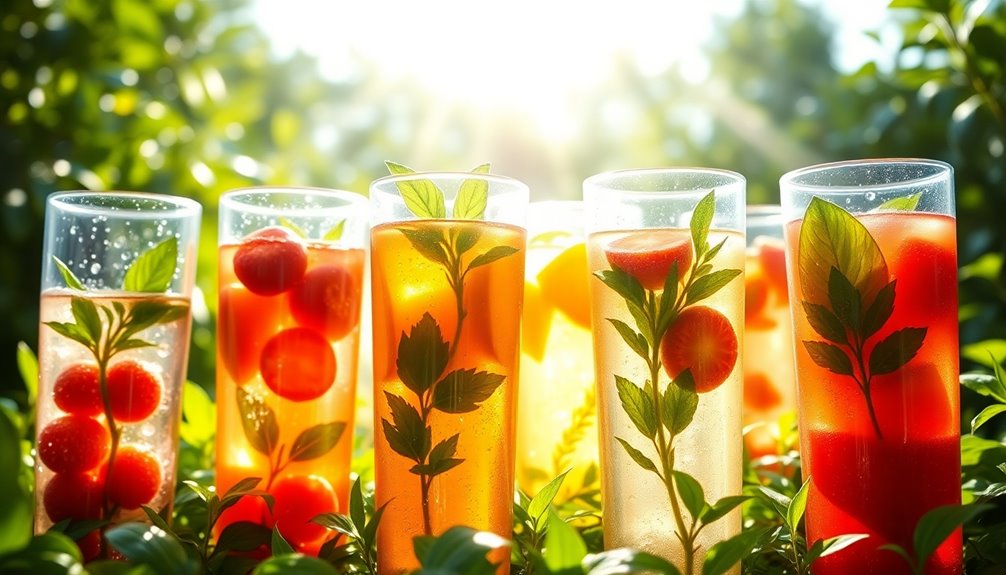
While many food packaging options contribute to waste, edible coatings stand out as a sustainable alternative that offers significant benefits. Made from natural ingredients like wax, starch, and proteins, these coatings create a barrier against moisture and oxygen, extending the shelf life of food products.
By eliminating the need for separate disposal, edible coatings promote a circular packaging approach. Regulatory bodies guarantee their safety, making them popular in the packaging industry for fresh produce and baked goods.
Research shows that these coatings can reduce food waste by up to 50%, enhancing freshness and compliance with environmental standards. Innovations using seaweed or fruit extracts not only minimize packaging waste but also provide additional nutritional benefits to consumers.
Future Trends in Sustainable Packaging Solutions for Beverages
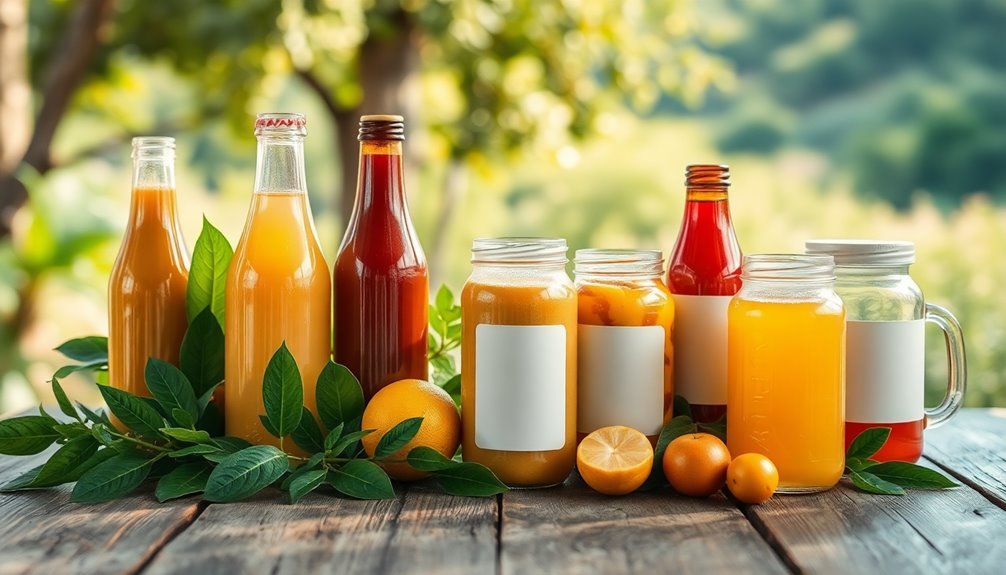
Sustainable packaging is reshaping the beverage industry, much like edible coatings have transformed food packaging.
You'll notice that bioplastics, like Polylactic Acid (PLA), are becoming common, offering a biodegradable alternative to conventional materials and reducing reliance on fossil fuels.
Innovations such as aseptic beverage cartons guarantee a longer shelf life while maintaining a lower carbon footprint, enhancing eco-friendly distribution.
Seaweed-based packaging, developed by companies like Notpla, decomposes within weeks, promoting waste reduction.
Additionally, reusable packaging systems from Tosca and Returnity support circular economy principles, minimizing waste through multiple uses.
As consumer demand for sustainable packaging grows, regulatory changes, like the EU's ban on single-use plastics, drive companies to adopt these eco-friendly practices in their beverage offerings. Moreover, many companies are exploring sustainable foraging techniques to source natural materials for packaging, further enhancing their commitment to environmental responsibility.
Frequently Asked Questions
What Is the Most Environmentally Friendly Packaging for Drinks?
When you're looking for the most environmentally friendly packaging for drinks, consider options like compostable paper and cardboard.
These materials break down easily, enriching the soil. You might also explore bioplastics made from renewable sources, which offer biodegradability.
Aseptic beverage cartons are great too, as they're sourced from renewable forests.
Ultimately, edible coatings can enhance freshness without waste.
What Packaging Is Most Environmentally Friendly?
Imagine a lush forest where trees shed their leaves, nourishing the earth. That's the essence of environmentally friendly packaging.
You'll find options like compostable materials that break down into rich soil and bioplastics made from renewable sources, reducing waste.
Biodegradable films and edible coatings extend the life of your products while minimizing impact.
How Do You Make Green Packaging?
To make green packaging, you'll first want to choose materials that are biodegradable or compostable, like bioplastics or recycled paper.
Consider innovative designs that minimize waste, such as foldable boxes or spouted pouches.
You can also explore using edible coatings to prolong your product's freshness without added waste.
Finally, always stay informed about regulations and consumer preferences to guarantee your packaging aligns with sustainability goals while meeting market demand.
What Are the Disadvantages of Banana Leaves Packaging?
Isn't it ironic that nature's gift, banana leaves, can actually bring challenges? You might think they're a perfect eco-friendly packaging solution, but they're prone to mold and spoilage if moisture gets trapped.
Their availability can be spotty, making them unreliable. Plus, they don't last long and can't protect your products from oxygen or humidity.
Conclusion
So, if you think sipping your organic juice from a plastic bottle is the pinnacle of sustainability, think again! Embracing green packaging isn't just a trend; it's your ticket to feeling like a superhero for the planet. With biodegradable materials and edible coatings, you can drink guilt-free while snubbing the villainous plastic. As we toast to the future, let's raise our compostable cups high—because nothing says "I care" like sipping responsibly and saving the Earth, one drink at a time!
Cindy thoroughly researches juicing trends, techniques, and recipes to provide readers with practical advice and inspiration. Her writing style is accessible, engaging, and designed to make complex concepts easy to understand. Cindy’s dedication to promoting the advantages of juicing shines through her work, empowering readers to make positive changes in their lives through the simple act of juicing.

